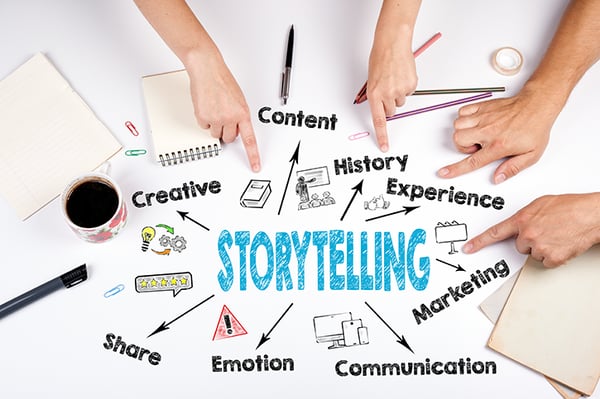
As consumers living in an interconnected world, we are constantly inundated with brands’ messaging in countless forms — commercials, sponsorships, billboards, email promos, digital ads, and more.
But because we are existing in an overwhelmingly information-filled era, much of the messaging we encounter actually goes unnoticed by us. So, how should marketing communications professionals best address this challenge?
In today’s oversaturated world of messaging, it is absolutely critical for marketing communications professionals to master the art of storytelling — a strategic method of envisioning, creating, and refining messaging that not only reaches your target audience, but inspires engagement.
Storytelling transcends; storytelling captivates; storytelling impacts. And that’s why storytelling is a vital marketing tool for marketing communications professionals today.
Discover the value of a cutting-edge online graduate marketing communications degree programs offered at WVU:
How Many Marketing Ads Do You See a Day?
Every time you do a Google search, drive through a city, listen to a podcast, or stream from your favorite television platform, you are exposed to countless advertisements that are all meant to communicate a message and capture your business.
In other words, you are interacting with brands nearly all the time:
Between 2020-2021 (when many industries were stunted by the COVID-19 pandemic), the advertising industry grew by 11.2 percent, which is significantly faster than the average for all occupations. Further, 2023 research shows that the average American consumer is exposed to 4,000-10,000 advertisements every single day — and the average internet user is shown over 1,700 banner ads every month.
These statistics may surprise you, but you are actually exposed to more brands and messaging than you even register. This means that a great deal of the messaging you are exposed to doesn’t even impact you enough to remember it.
So, how can marketing professionals ensure that their messaging is not only reaching their target audience, but also implementing strategies to capture that audience’s attention? Let’s dive deeper.
How to Use Storytelling in Marketing Communications
Marketers are competing against countless other brands vying for their audiences’ attention. As such, it is critical that marketers put forth integrated communications across channels. Storytelling allows marketers to unify their communications with their brand itself — creating consistent, impactful stories that are memorable to the user.
But using storytelling in marketing communications is not just about developing more content or putting more money behind digital advertising communications. Rather, it is developing a marketing strategy that is rooted in effective storytelling which takes introspection, creativity, data analysis, and organized implementation.
Here are a few crucial steps to mastering storytelling strategies in marketing communications today.
1. Analyze your target audience
Who are you trying to reach? Determining your target audience will be paramount to envisioning, developing, and refining a storytelling strategy that will reach them and inspire engagement. Once you know your target audience, develop a persona:
2. Develop a persona
What does your target audience really look like? Be intentional and drill down into the specifics by analyzing your audience’s experiences, questions, goals, pain points, and motivations. In developing a persona, use analysis to determine the kinds of content — the kinds of stories — that will most effectively impact them:
2. Craft a relatable narrative
What kinds of stories are going to be effective? Once you’ve identified the specifics of your persona, it’s crucial that you uncover the kinds of themes and narratives that are going to capture their attention and inspire their action. After identifying a strategic, impactful narrative, focus on implementing an integrated marketing strategy for max reach and ROI:
4. Brainstorm an integrated marketing strategy
How do you implement an effective marketing strategy? With your audience, persona, and narratives in mind, you will collaborate with other expert marketing professionals across teams to produce messaging that is consistent across myriad channels of media. By utilizing diverse channels, all pieces of marketing communications will connect the consumer to the brand. This harnesses the power of human-centered marketing strategy and will engage the targeted audience through reinforced brand messaging.
Exploring WVU’s Graduate Marketing Communications Degrees
At West Virginia University, we offer multiple graduate programs that are rooted in marketing communications.
We are the first university to offer a Master of Science in Integrated Marketing Communications and the only university to offer a Master of Science in Data Marketing Communications — both cutting-edge graduate degrees that are designed for both emerging and seasoned marketing professionals alike. 
We also offer a Master of Science in Digital Marketing Communications and a variety of graduate certificates in marketing communications. Each program is designed to give you the strategic, relevant skills needed to secure a lifelong career in marketing communications — no matter your specific role or industry.
Ready to explore our online marketing communications degrees? Find out more today.

Join a Community of Cutting-Edge Marketing Professionals at WVU
At the WVU Reed College of Media, we are dedicated to producing graduates who have the skills, talent, and marketability to meet a critical market demand for more strategic marketing communications professionals. No matter your industry of interest, you will graduate with a master’s degree in marketing communications that will serve as a launching pad for your dream career.
Ready to take the next step? Request more information or visit our website for more program details. You can also learn more about applying to one of our online programs here.









